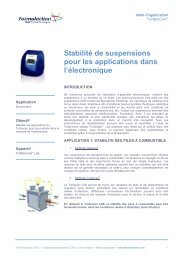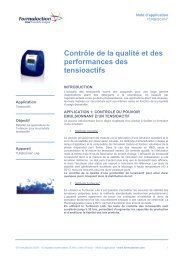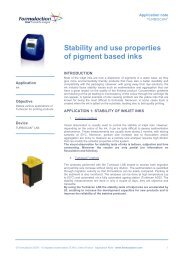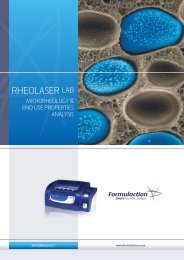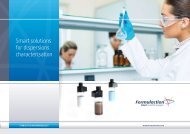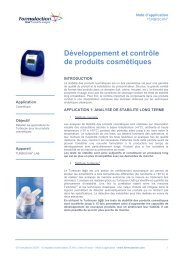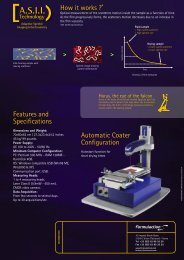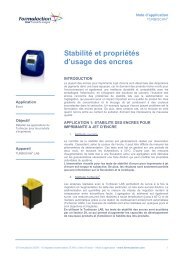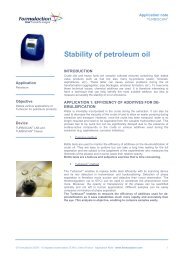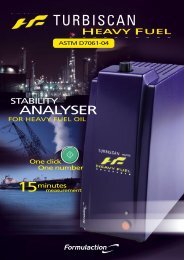Doc technik.pdf - Formulaction
Doc technik.pdf - Formulaction
Doc technik.pdf - Formulaction
Create successful ePaper yourself
Turn your PDF publications into a flip-book with our unique Google optimized e-Paper software.
TURBISCAN<br />
THE REFERENCE<br />
FOR STABILITY ANALYSIS<br />
The Turbiscan range is world widely used in order to<br />
characterize the dispersion state of emulsions, suspensions,<br />
foams...<br />
Changes in terms of size and concentration (such<br />
as creaming, sedimentation, flocculation or coalescence...)<br />
are directly monitored, in realistic conditions<br />
enabling faster and more relevant characterization<br />
compared to common methods such as visual observation<br />
or centrifugation, which are time-consuming or<br />
non-realistic.<br />
Users have now the easiest way ever to check the stability<br />
of their formulations with a one-click access to<br />
the Turbiscan Stability Index ( ).<br />
Light Source<br />
(Near IR)<br />
Backscatter<br />
Detector<br />
Transmission<br />
Detector<br />
MULTIPLE LIGHT SCATTERING<br />
All Turbiscans work on the same principle. This technique<br />
consists in sending photons (light) into the sample.<br />
These photons, after being scattered many times<br />
by objects in suspension (droplets, solid particles, gas<br />
bubbles, …) emerge from the sample and are detected<br />
by the measurement device of the Turbiscan.<br />
MEASUREMENT PRINCIPLE<br />
A mobile reading head, composed of a NIR diode and<br />
two detectors (transmission (T) and backscattering<br />
(BS)), scans a glass cell containing the sample. The<br />
Turbiscan software then enables to interpret the obtained<br />
data easily.<br />
The measurement enables the quantification of<br />
several parameters, as BS and T values are linked to<br />
particles average diameter (d) and volume fraction (ϕ).<br />
BS = f ( d /ϕ)<br />
SCREENING<br />
STABILITY TESTS:<br />
TURBISCAN CLASSIC<br />
BENEFITS<br />
VERSATILE TECHNOLOGY<br />
User can study all kinds of liquid<br />
dispersions (emulsions, suspensions,<br />
foams, …), with concentration<br />
up to 95% v/v, over a wide<br />
range of size (10 nm to 1 mm).<br />
OPTICAL AND THERMAL<br />
ACCELERATION<br />
Thanks to the high optical<br />
resolution and the possibility of<br />
important storage temperatures,<br />
detection of the samples ageing is<br />
accelerated up to 200 times.<br />
NON CONTACT<br />
MEASUREMENT<br />
Measurement is done without any<br />
mechanical or external stress, and<br />
without any dilution, thus allowing<br />
to monitor the ageing of the<br />
product in realistic conditions.<br />
EASY SAMPLE HANDLING<br />
Measurement is performed in a<br />
disposable glass cell, preventing<br />
evaporation or drying, requiring<br />
absolutely no sample preparation<br />
(such as dilution).<br />
AGEING &<br />
CHARACTERISATION :<br />
TURBISCAN LAB



